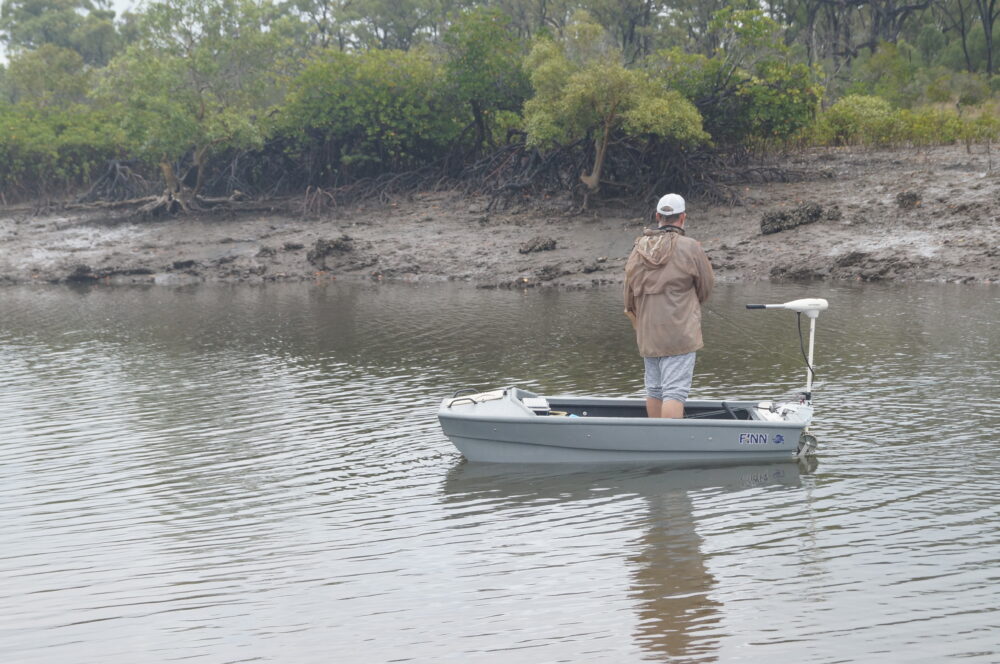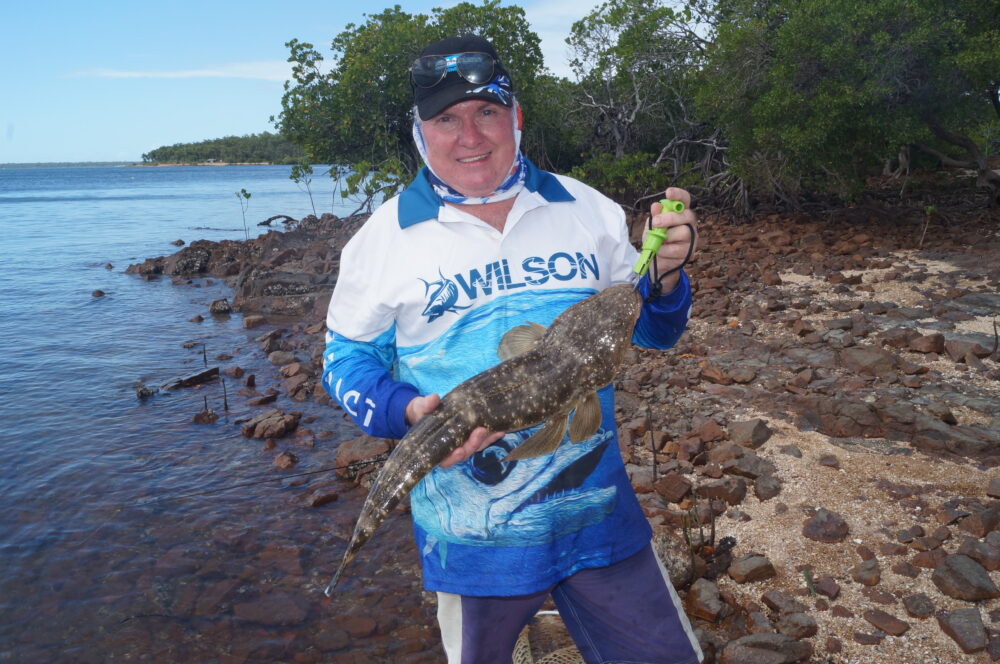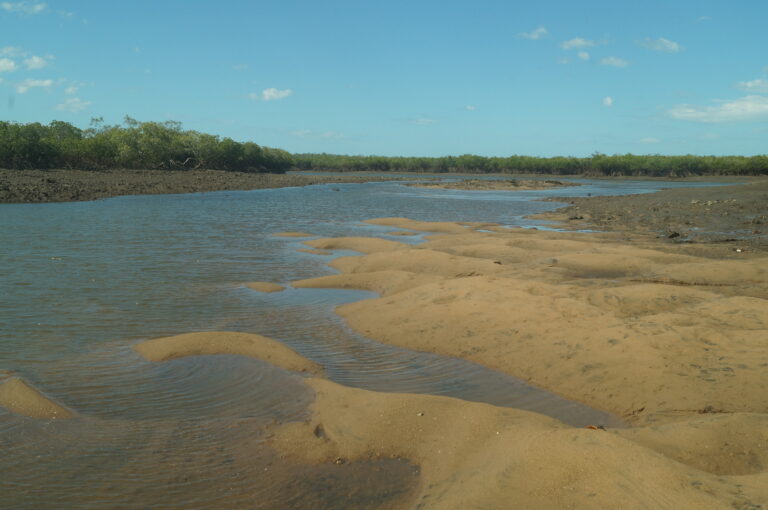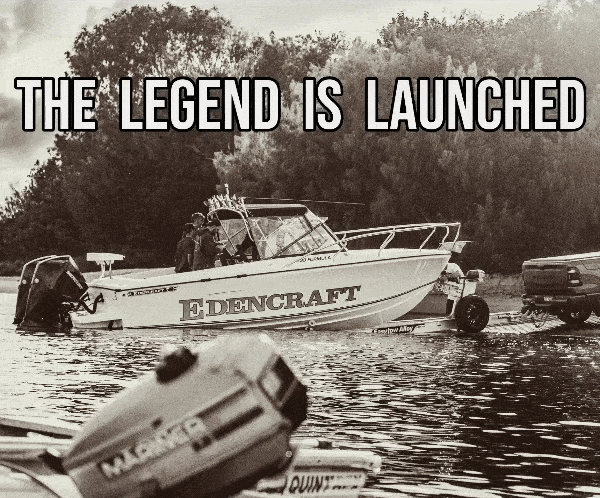A Current Affair – By Dave Magner
If you have read any of my recent articles, you’ll have noticed that lately I’ve been spending a lot of time fishing my local estuaries. More specifically, I’ve been fishing right up in the shallows, either in my tiny boat or kayak. You’d also have realised that I’ve been having a ball chasing traditional ‘bread and butter’ species like grunter, bream, and flathead using 2 kilo spin gear.
Playing around on the light tackle like this has made a nice change from my regular offshore trips, where I normally target heavyweights like mackerel, tuna, and trevally. On ‘bream gear’, even average sized fish become a challenge again and when you do hook something bigger, the fight really does become memorable.
Those grunter in particular are absolute pocket rockets.
If you think bream and flatties go okay, then you are in for a hell of a shock when you hook your first 50cm plus grunter up in the shallows. They get your drag singing like nothing else and are way under-rated as sportsfish. As an added bonus, they are damn good on the plate to boot.
Anyway, one of the benefits of spending so much time sight casting up in the shallows has been re-learning some of the absolute fundamentals of estuary fishing, like just how big a role current plays in dictating where the fish will be at any given stage of the tide. I’ve been experiencing firsthand how the right amount of water movement attracts and concentrates my target species and how the water flowing in the right direction can turn the most ordinary looking bit of bank into an absolute hot spot.

Small, deep diving plugs like this Berkley diver can be useful when extracting fish from low tide holes.
I’ve also learned never to overlook places because they appear too shallow to hold fish and I’ve been seeing fish in runs that wouldn’t get your knees wet. I’d actually go so far as to say that current is the critical factor that I now look for when trying to locate feeding fish in any shallow waterway.
Three Lessons
There have been three really obvious examples that spring to mind which illustrate just how important current flow can be.
The first was up the back of Colosseum Inlet. On this trip, the tidal range was much larger than I normally like to fish up there, but I thought I would still give it a go and see what happened. Well, what happened was that a very low, low-tide all but drained the creek dry. It was way too shallow to even get the Hobie through. So, while I waited for the last of the run out to end, I had no choice but to sit in a little pocket of slightly deeper water.
I guess I should explain that by deeper water, I mean this spot was probably just under a metre deep. It was around mid-day too, so the sun was beating down and it was bloody hot. Given the conditions I really didn’t expect to catch much until the tide had turned and a bit of run in started to refill the creek again.
Anyway, there was a small rock shelf on the upstream end of the hole, and with the tide so low, just about the only water left in the creek was draining down over the lip and dropping into the pocket I was sitting in. I fired a cast upstream and wound the lure back towards me. I could feel it bouncing over the shallow rocks as it made its way downstream then, as it passed over that small drop-off it got hammered.

Watch the water flow and work the structure and you can have some great light tackle fishing in our CQ creeks and estuaries.
I was only using light tackle and the savagery of the hit took me completely by surprise. I put as much load on the rod as I dared and peddled the kayak to take me away from the rocks I could see not that far below. Luckily everything held together and I was able to land an estuary cod which was a lot bigger than expected.
I then went on to land a few more fish, mainly a mix of slightly smaller cod, bream, and little tackers like Moses perch from that spot. From memory, I also got dusted once or twice too. I really found it hard to believe there were so many fish in one small hole about the size of my living room. It seems they were all there waiting for the current to funnel their food right to them.
The next example happened in the same stretch of creek, just a few hundred metres upstream. Again, it was low tide and the water was so shallow, I had to get out and drag my tiny boat through a narrow stretch of rock strewn shallows. As I dragged the boat along behind, I started noticing fish busting out of the sand and shooting off ahead of me. Yep, there in the shallows were a number of small flatties, as well as a much larger stingray that nearly gave me a heart attack when I almost stood on it.
That water was no more than twenty centimetres deep, yet there were fish queued up there, allowing the current to bring their tucker to them. Again, this was in the middle of the day, with the hot sun beating down. Okay, none of the flatties were huge but to see such a concentration of them in such shallow water really got me thinking.
The final example happened in Seven Mile Inlet, which is next door to Colosseum. This time the day was really windy and while we used my Stabicraft to get there, the best fishing turned out to be from the bank.
We pulled the boat up on a sandy little beach, and casting soft plastics out into a bit of a hole I had located earlier using the sounder produced a nice feed of grunter. Once the tide started running in a bit harder though, the fish had vacated the hole and moved on.

Cod are ambush predators. Find somewhere with a bit of structure that constricts the flowing water and they won’t be far away.
A slight shift upstream had us pulled up on a very shallow sand bank. I spent a bit of time casting out into the channel, but couldn’t generate any serious interest, apart from a small barracuda. For something different, I started wading up the bank into the flow. Making long casts parallel to the bank brought an almost immediate change of luck. I had a big flathead follow the little Shimmy lure almost back to my feet. I’m guessing he saw me though, as he dived straight the bottom and refused to eat my lure, even when it was retrieved straight over his nose. After a series of casts, he appeared to get upset with it all and he took off for parts unknown.
I’d barely taken another couple of steps up the bank when I made another parallel cast and as I retrieved the lure, I felt it snag up on one of the rocks just ahead of me. As I tried to walk forward to free it, the snag started swimming and I realized it was another good sized flathead. As I had no landing net, I had to walk the fish back to the sand so I could land it. Unfortunately, it had swallowed the lure right down, which made it difficult to release, so I decided to keep it, with a couple of the grunter we caught earlier for dinner.
It was not a huge fish, being about 65cm long, but it was one of those real deep bodied flatties that provide big, thick, juicy fillets. It was certainly a lot smaller than the fish which I’d missed earlier. Now we don’t tend to get a lot of bigger flatties here, so when you find two solid lizards so close together, there just has to be a logical reason why.

Gun Bundaberg angler Peter Myles with a flathead from the shallows behind him. It’s a decent fish given it was caught less than a rod length from the shore.
Before we left for the trip home, I made my way back up to the scene of the action to try and identify what that reason was. The answer was simple. At that stage of the tide, a couple of the larger rocks formed a short wall which deflected the incoming tide in towards the bank. This had the effect of constricting and speeding up the flow, funneling any potential food into a narrow strip adjacent to the shore.
At that particular point in time, it was like Uber Eats for flatties.
Watch the Water
Okay, so there were no trophy fish caught in the incidents mentioned, but that doesn’t decrease the value of the lessons. In each case, water was being funneled at a certain location, at a particular stage of the tide. When the conditions were just right, the current flow acted like a fish magnet, pulling fish in from the surrounding area to take advantage of the feeding opportunities it created. To double check my observations, I’ve since gone back and tried a couple of these spots at different stages of the tide and even on different tides and the action is nowhere near the same.
The simple thing to remember is that shallow water is rarely too shallow to hold fish, at least as long as there is some sort of feature to constrict and funnel the current. I’m sure if you look around your local fishing spot you will notice places similar to the ones I’ve mentioned. Give them a try and you might be surprised at the size of the fish that will venture into the shallows to take advantage of the current.






